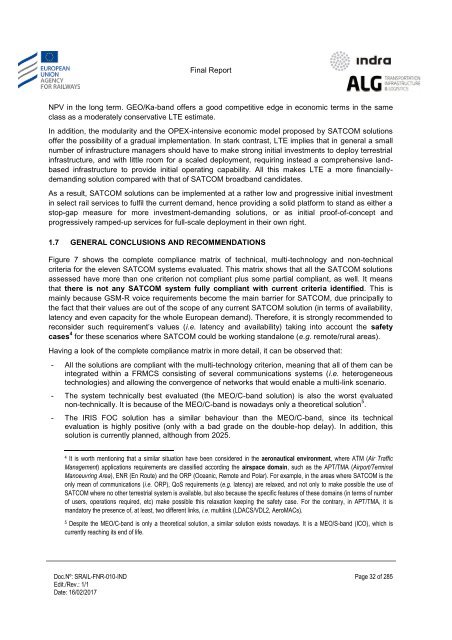Study on feasibility of SATCOM for railway communication
SRAIL-FNR-010-IND%20-%20FinalReport_v1.1_20170216
SRAIL-FNR-010-IND%20-%20FinalReport_v1.1_20170216
You also want an ePaper? Increase the reach of your titles
YUMPU automatically turns print PDFs into web optimized ePapers that Google loves.
Final Report<br />
NPV in the l<strong>on</strong>g term. GEO/Ka-band <strong>of</strong>fers a good competitive edge in ec<strong>on</strong>omic terms in the same<br />
class as a moderately c<strong>on</strong>servative LTE estimate.<br />
In additi<strong>on</strong>, the modularity and the OPEX-intensive ec<strong>on</strong>omic model proposed by <strong>SATCOM</strong> soluti<strong>on</strong>s<br />
<strong>of</strong>fer the possibility <strong>of</strong> a gradual implementati<strong>on</strong>. In stark c<strong>on</strong>trast, LTE implies that in general a small<br />
number <strong>of</strong> infrastructure managers should have to make str<strong>on</strong>g initial investments to deploy terrestrial<br />
infrastructure, and with little room <strong>for</strong> a scaled deployment, requiring instead a comprehensive landbased<br />
infrastructure to provide initial operating capability. All this makes LTE a more financiallydemanding<br />
soluti<strong>on</strong> compared with that <strong>of</strong> <strong>SATCOM</strong> broadband candidates.<br />
As a result, <strong>SATCOM</strong> soluti<strong>on</strong>s can be implemented at a rather low and progressive initial investment<br />
in select rail services to fulfil the current demand, hence providing a solid plat<strong>for</strong>m to stand as either a<br />
stop-gap measure <strong>for</strong> more investment-demanding soluti<strong>on</strong>s, or as initial pro<strong>of</strong>-<strong>of</strong>-c<strong>on</strong>cept and<br />
progressively ramped-up services <strong>for</strong> full-scale deployment in their own right.<br />
1.7 GENERAL CONCLUSIONS AND RECOMMENDATIONS<br />
Figure 7 shows the complete compliance matrix <strong>of</strong> technical, multi-technology and n<strong>on</strong>-technical<br />
criteria <strong>for</strong> the eleven <strong>SATCOM</strong> systems evaluated. This matrix shows that all the <strong>SATCOM</strong> soluti<strong>on</strong>s<br />
assessed have more than <strong>on</strong>e criteri<strong>on</strong> not compliant plus some partial compliant, as well. It means<br />
that there is not any <strong>SATCOM</strong> system fully compliant with current criteria identified. This is<br />
mainly because GSM-R voice requirements become the main barrier <strong>for</strong> <strong>SATCOM</strong>, due principally to<br />
the fact that their values are out <strong>of</strong> the scope <strong>of</strong> any current <strong>SATCOM</strong> soluti<strong>on</strong> (in terms <strong>of</strong> availability,<br />
latency and even capacity <strong>for</strong> the whole European demand). There<strong>for</strong>e, it is str<strong>on</strong>gly recommended to<br />
rec<strong>on</strong>sider such requirement‘s values (i.e. latency and availability) taking into account the safety<br />
cases 4 <strong>for</strong> these scenarios where <strong>SATCOM</strong> could be working standal<strong>on</strong>e (e.g. remote/rural areas).<br />
Having a look <strong>of</strong> the complete compliance matrix in more detail, it can be observed that:<br />
- All the soluti<strong>on</strong>s are compliant with the multi-technology criteri<strong>on</strong>, meaning that all <strong>of</strong> them can be<br />
integrated within a FRMCS c<strong>on</strong>sisting <strong>of</strong> several communicati<strong>on</strong>s systems (i.e. heterogeneous<br />
technologies) and allowing the c<strong>on</strong>vergence <strong>of</strong> networks that would enable a multi-link scenario.<br />
- The system technically best evaluated (the MEO/C-band soluti<strong>on</strong>) is also the worst evaluated<br />
n<strong>on</strong>-technically. It is because <strong>of</strong> the MEO/C-band is nowadays <strong>on</strong>ly a theoretical soluti<strong>on</strong> 5 .<br />
- The IRIS FOC soluti<strong>on</strong> has a similar behaviour than the MEO/C-band, since its technical<br />
evaluati<strong>on</strong> is highly positive (<strong>on</strong>ly with a bad grade <strong>on</strong> the double-hop delay). In additi<strong>on</strong>, this<br />
soluti<strong>on</strong> is currently planned, although from 2025.<br />
4<br />
It is worth menti<strong>on</strong>ing that a similar situati<strong>on</strong> have been c<strong>on</strong>sidered in the aer<strong>on</strong>autical envir<strong>on</strong>ment, where ATM (Air Traffic<br />
Management) applicati<strong>on</strong>s requirements are classified according the airspace domain, such as the APT/TMA (Airport/Terminal<br />
Manoeuvring Area), ENR (En Route) and the ORP (Oceanic, Remote and Polar). For example, in the areas where <strong>SATCOM</strong> is the<br />
<strong>on</strong>ly mean <strong>of</strong> communicati<strong>on</strong>s (i.e. ORP), QoS requirements (e.g. latency) are relaxed, and not <strong>on</strong>ly to make possible the use <strong>of</strong><br />
<strong>SATCOM</strong> where no other terrestrial system is available, but also because the specific features <strong>of</strong> these domains (in terms <strong>of</strong> number<br />
<strong>of</strong> users, operati<strong>on</strong>s required, etc) make possible this relaxati<strong>on</strong> keeping the safety case. For the c<strong>on</strong>trary, in APT/TMA, it is<br />
mandatory the presence <strong>of</strong>, at least, two different links, i.e. multilink (LDACS/VDL2, AeroMACs).<br />
5<br />
Despite the MEO/C-band is <strong>on</strong>ly a theoretical soluti<strong>on</strong>, a similar soluti<strong>on</strong> exists nowadays. It is a MEO/S-band (ICO), which is<br />
currently reaching its end <strong>of</strong> life.<br />
Doc.Nº: SRAIL-FNR-010-IND<br />
Edit./Rev.: 1/1<br />
Date: 16/02/2017<br />
Page 32 <strong>of</strong> 285


